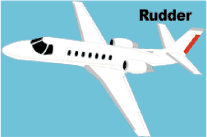Whenever I get in an airplane with a pilot for recurrent training, I can assure myself that I will mention rudder usage more than once during the flight. If it is in a tailwheel (or if the pilot is doing tailwheel training), I’m going to mention the rudder a lot. How do I know this? Because basic rudder skills are actually one of the most difficult things to master in flying.
Let’s start simple. What does the rudder do? The dictionary definition is it controls the movement about the vertical axis of the airplane. If you stick a pole down through the CG of the airplane and rotate the airplane around that pole, this is the vertical axis. Looking at it another way, the rudder moves the airplane’s nose left and right. Keep this in mind as we move on.
Every pilot thinks about the rudder during the takeoff roll. Because of the torque effect, the pilot must add right rudder during the takeoff roll to stay on the runway centerline. Depending on the airplane’s horsepower, more rudder pressure is needed in higher powered airplanes. The problem usually shows up once the airplane gets in the air.
In the worst situation, after takeoff, the pilot will set both feet on the floor and completely disregard the rudder. Torque effect and now P-factor are continuing to cause the airplane to yaw left, causing the need for right rudder. With his feet on the floor, though, the pilot is allowing the airplane to yaw. It’s not terribly noticeable for him in the front seat, but the back seat passengers (especially in a six seat or larger airplane) are certainly feeling it.
One particular problem spot on the climb is the climbing left turn. In a climbing left turn, training says to add left rudder since it is a left turn (see below for the reasoning). But, since the airplane is climbing and therefore experiencing left yawing tendencies due to the aforementioned effects, the pilot needs to continue pressing the right rudder, though the pressure won’t be as much as in a straight climb. Watch the ball the next time you make a climbing left hand turn and it’ll make a believer out of you.
I find only a handful of pilots are this egregious. Most pilots have rudder problems in turns and in turbulence. We’ll tackle turns first. As we all learned when we first started flying, due to adverse yaw, a pilot must add rudder in the turn’s direction. Again, this isn’t usually where the problem shows up. During the rollout is the problem area.
Let’s take a turn to the left. The pilot rolls in, adding left rudder, arrives at his heading, then begins to roll out with the ailerons. Left adverse yaw is now being experienced and right rudder is needed to smoothly transition back to level flight. Need some visual assistance? Watch the nose the next time you make a turn. If you are working the rudder properly, the nose will pivot on one point in the horizon. If you aren’t using the rudder properly, the nose will draw a U shape on the horizon. Try making some turns without rudder, see what it looks like, then use the rudder properly. You’ll notice a big difference.
Finally, let’s talk turbulence. As we all know, turbulence in the hot summer afternoon is quite pronounced. When the airplane experiences a bump, it usually doesn’t bounce straight up in the air. There is usually some kind of rolling motion involved. As the pilot corrects this rolling motion by moving the ailerons, adverse yaw is experienced (just like rolling into and out of a turn that we talked about above), so rudder is needed. There isn’t a need to stomp on the rudder or you’ll cause the airplane to severely yaw in the other direction, but rudder pressure is needed.
Final approach is where this gets most pilots. By controlling the nose and not allowing it to move around on final by using the rudder, this will make your approaches a little more stabilized leading to a more successful landing.
Feeling lost when it comes to the rudder? Ask your instructor the next time you go fly to do some rudder exercises. Most instructors don’t emphasize these basic stick and rudder skills which leaves pilots lacking as they move on in their aviation lives. So make it a point to do some basic rudder work the next time you fly with your instructor.

